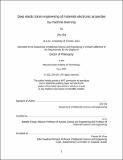Deep elastic strain engineering of materials electronic properties by machine learning
Author(s)
Shi, Zhe
DownloadThesis PDF (7.100Mb)
Additional downloads
Advisor
Li, Ju
Terms of use
Metadata
Show full item recordAbstract
The introduction of elastic strains has become an appealing strategy for providing unique and exciting electronic properties in nanostructured materials. Recent successes in diamond and silicon deformation experiments further extended the applicable strain levels in these materials, harbingering a new stage of elastic strain engineering of semiconductor fundamental electronic properties and device performance. However, it is not generally easy to know from experiments how much an electronic property change is for materials undergoing bending or even uniaxial tension, let alone designing the optimal combination of functional properties for the material in a vast and more complex six-dimensional (6D) strain space. The complexity of controllably engineering materials properties in such a 6D strain space necessitates high-fidelity high-efficiency computer screening for a desirable figure-of-merit and then designing a proper straining pathway to guide future experiments.
To address this challenge, we developed in this thesis a general framework that combines machine learning and a limited amount of ab initio calculations to guide strain engineering whereby basic electronic properties are designed. Our method invokes deep neural networks, convolutional neural networks, data fusion, and active learning algorithms, allowing for accurate and efficient prediction of strain-dependent fundamental electronic properties such as band structure, bandgap, band extrema location, and effective mass, as well as other properties with minor modifications. It is also used for discovering indirect-to-direct bandgap transition that would benefit photon emission and absorption in a semiconductor such as silicon by scanning the entire strain space.
Integrating this method with finite-element simulations, we predicted energy-efficient strain pathways that would reversibly transform an ultrawide-bandgap material such as diamond to a metalized state in an experimentally feasible geometry. The fast and reliable inference of the proposed framework opens a path beyond analyzing and scrutinizing electronic band structures. In particular, an application of this framework in the studies of phonon band structure and phonon stability of diamond yielded a visualization and theoretical understanding of the deep elastic strain engineering boundary in the vast 6D strain space. We also applied the machine learning models to investigate the strain-induced variations of defect ionization energy and predicted deep-to-shallow defect level transition in diamond, offering a theoretical possibility to make strain-controlled switchable devices with doped diamond.
We illustrate the applications of the method with results for silicon and diamond, although the general technique presented here is potentially useful for optimizing figures-of-merit for a variety of semiconductors, providing guidance for experimentally tailoring materials properties via deep elastic strain engineering for electronic, photonic, and energy applications.
Date issued
2021-06Department
Massachusetts Institute of Technology. Department of Materials Science and EngineeringPublisher
Massachusetts Institute of Technology